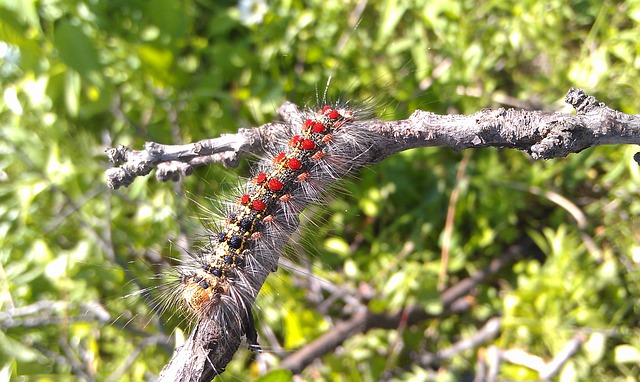This is the fifth part of a series on spring tree insects. This article examines gypsy moth, and hemlock wooly adelgid.
Introduction
In spring, deciduous trees break dormancy, and resume the growing process. During this period, many insects become active, emerging from their overwintering sites to plague their hosts. The following describes some of the insects that may be commonly observed in spring, and how they can impact susceptible trees.
Gypsy Moth (Lymantria dispar dispar)
Lymantria dispar dispar, also known as gypsy moth, European gypsy moth, or North American gypsy moth, is a moth in the family Erebidae. Each year, Gypsy moth is responsible for defoliating millions of trees across Europe, Africa, Asia, and North America. Gypsy moth is classified as a pest. Its larvae consume the leaves of over five hundred species of trees and shrubs. It is considered one of the most destructive insects of hardwood trees in the eastern United States.
Hosts
Gypsy moth larvae favor hardwoods. In the eastern United States, gypsy moth defoliates oaks, aspen, apple, sweetgum, speckled adler, basswood, gray birch, paper birch, white birch, poplar, willow, and hawthorn, among other species. Older larvae are attracted to several species of hardwood that younger larvae avoid, including hemlock, cottonwood, Atlantic white cypress, southern white cedar, pine, and spruce. Gypsy moth avoids ash trees, tulip-tree, American sycamore, butternut, black walnut, catalpa, flowering dogwood, balsam fir, cedar, American holly, mountain laurel, and rhododendrons.
Symptoms of Infestation
Gypsy moth defoliates susceptible trees. The effects of defoliation range in severity. They depend on the amount of foliage that is removed, the number of consecutive defoliations, the condition of the tree, the tree’s hardiness, and soil conditions. If less than half of the crown is defoliated, most hardwoods will experience a slight reduction in radial growth. If more than half of the crown is defoliated, most hardwoods will produce a second flush of foliage during summer. Aside from hardwoods, pines and hemlocks may be defoliated during gypsy moth outbreaks.
Trees that are healthy and vigorous can generally withstand defoliation. However, if subjected to continuous defoliation, trees will eventually become stressed. Trees that are weakened by stress may be killed if more than half of the crown is defoliated. Trees that have been weakened by defoliation, or other stressors are also vulnerable to disease pathogens, and additional insect infestations. The Armillaria fungus often infiltrates the root system of weakened trees, while chestnut borer invades the trunk and branches.
Treatment
- When planting in landscape settings, select a diverse composition of trees and shrubs, including species that are not favored by gypsy moth, such as honeylocust, ash, hickory, dogwood, mountain ash, tulip, yellow poplar, or many conifers, excepting pines and hemlocks. Enhance growing conditions for isolated trees by encircling them with ground cover plants that will not compete with them for moisture and nutrients.
- Remove and dispose of any dead branches, or flaps of bark. This will reduce the number of sheltered locations available to larvae and pupae.
- Eliminate egg masses found on trees, shrubs, buildings, fencing, vehicles, and woodpiles.
- Barrier bands composed of double-sided sticky tapes, or adhesive material like petroleum jelly or grease can be used to prevent larvae from crawling up the trunks of susceptible trees. These products should be applied to the surface of impermeable material, such as duct tape or tar paper. Avoid applying any material directly to the bark. Petroleum based products can cause swelling and cankering on trees with thin bark.
- Fertilize trees to maintain vigor, and promote healthy growth.
- Applying a layer of organic mulch around the base of trees and shrubs will improve soil conditions, maintain soil quality, and moderate soil moisture.
- Ensure that trees are sufficiently watered, especially during periods of drought.
- Avoid applying lime or weed killers near trees, particularly those with shallow root systems. Many commercially available chemicals can damage tree roots.
- Dense populations of gypsy moth can be reduced through the use of pesticides. Microbial and biological pesticides should be applied before the larvae reach the third instar. As they mature, larvae become more resistant to microbial pesticides.
Hemlock Wooly Adelgid (Adelges tsugae)
Hemlock wooly adelgid, or HWA, is a small insect that is native to southern Japan. It is one of the most common species of adelgid, and a significant pest of hemlock. The insect was first discovered in North America in the early 1950’s near Richmond, Virginia. In the eastern United States, it has established itself as a common invasive pest of eastern hemlock and Carolina hemlock.
Hosts
Hemlock wooly adelgid can develop and reproduce on any species of hemlock, but eastern hemlock and Carolina hemlock are the most vulnerable to infestation.
Symptoms of Infestation
Hemlock wooly adelgid produces two generations each year: a spring generation and a winter generation. As they develop, the adelgid feed on the starch reserves that are critical to a hemlock’s growth. As the insect drains the hemlock’s reserves, it causes the tree to decline, resulting in its failure. Additional stressors such as drought, poor soil conditions, and the presence of other insects or diseases can accelerate a hemlock’s decline.
Treatment
- Adelgid are often dispersed as a result of rainfall and heavy winds. They may also be transported to vulnerable trees by animal vectors, particularly birds. As such, bird feeders should be kept safely away from healthy or infested hemlocks.
- Chemical treatments, such as foliar sprays, or systemic insecticides, have proven to be effective at treating individual trees in nonenvironmentally sensitive areas. Systemic insecticides can either be applied to the soil around the base of the tree, or injected directly into the stem. Chemical treatments serve as a short term solution, and need to be applied repeatedly over time in order to maintain their efficacy.
- Various pathogens and predators feed exclusively on adelgid. As these predators become established in the infested area, they can help offset the spread of adelgid, and reduce its population.


